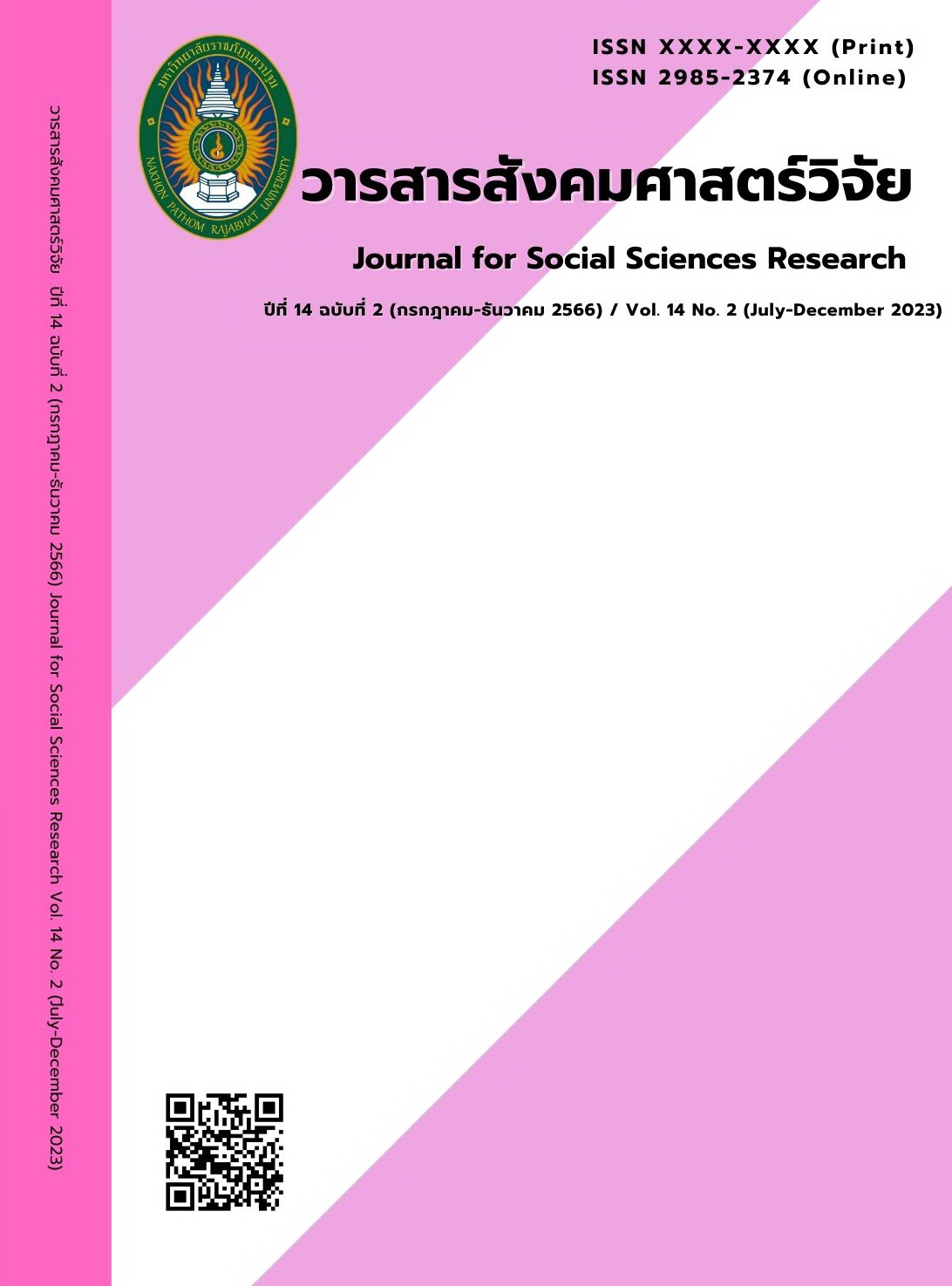PARTICIPATION IN HILL WATER SUPPLY MANAGEMENT ON THE DROUGHT CONDITION OF THE PEOPLE IN MAE LO WATERSHED, MAE RIM DISTRICT, CHIANG MAI PROVINCE
Main Article Content
Abstract
This mixed methods research aimed to: 1) study the participation level in managing the hill water supply system; 2) analyze the factors associating to public participation in managing the hill water supply system; and 3) synthesize the policy recommendations on hill water supply system management during drought conditions based on community participation. The research sample consisted of 180 locals in Mae Lo Watershed, Mae Rim District, Chiang Mai Province, and 21 stakeholders. Data were collected through a questionnaire, an informal interview, and a focus group discussion. The data were analyzed using descriptive statistics, correlation analysis, and content analysis. The results showed that the public participation in managing hill water supply systems during drought conditions was at a moderate level. The attitude towards the hill water supply system problems in drought conditions had positive correlations with the public participation in water supply management during drought conditions with statistical significance level at .05 (r = 0.383, p–value = 0.026). In conclusion, the stakeholders have suggested policy recommendations for promoting public participation in managing the hill water supply system during drought conditions as follows: 1) giving all households the right to equally access hill water supply; 2) preparing a systematic water management plan for consumption; and 3) getting support from local administrative organizations in management.
Article Details

This work is licensed under a Creative Commons Attribution-NonCommercial-NoDerivatives 4.0 International License.
บทความที่ได้รับการตีพิมพ์เป็นลิขสิทธิ์ของมหาวิทยาลัยราชภัฏนครปฐม
เนื้อหาของแต่ละบทความเป็นทัศนะของผู้เขียน ซึ่งที่ปรึกษา บรรณาธิการ กองบรรณาธิการ และคณะกรรมการบริหารวารสารไม่จำเป็นต้องเห็นด้วย หรือร่วมรับผิดชอบใดๆ
References
กรรมการประปาหมู่บ้าน ก, กรรมการประปาหมู่บ้าน. (2566). สัมภาษณ์. 2 พฤษภาคม.
กรรมการประปาหมู่บ้าน น, กรรมการประปาหมู่บ้าน. (2566). สัมภาษณ์. 28 พฤษภาคม.
เกศสุดา โภคานิตย์ และกีฬา หนูยศ. (2563). สภาพปัญหาการบริหารจัดการน้ำเพื่ออุปโภค บริโภคของชุมชนบ้านนาสีนวล ตำบลนาเสียว อำเภอเมืองจังหวัดชัยภูมิ. Journal of Modern Learning Development, 5 (3), 93-106.
ขวัญใจ เปือยหนองแข้ และยุภาพร ยุภาศ. (2563). แนวทางส่งเสริมการมีส่วนร่วมของเครือข่ายประชาชนในการบริหารจัดการภัยแล้งด้วยนวัตกรรมธนาคารน้ำใต้ดิน. วารสารการบริหารการปกครองและนวัตกรรมท้องถิ่น, 4 (3), 311-324.
ประชาชน ป, ผู้ใช้น้ำ. (2566). สัมภาษณ์. 2 พฤษภาคม.
วชิรวัชร งามละม่อม. (2559). ทฤษฎีการมีส่วนร่วม. ค้นเมื่อ 4 มิถุนายน 2566, จาก http://learningofpublic.blogspot.com/2016/02/blog-post_79.html
วิลาสินี ธนพิทักษ์, ณัฐนนท์ อินทร์ชุม, จารุวรรณ ชูสงค์, จรวยพร นุ่มน้อย และวิจิตรา อมรวิริยะชัย. (2560). การจัดการน้ำแล้งโดยการมีส่วนร่วมของชุมชนต้นน้ำท่าแนะ ตำบลเขาปู่ อำเภอศรีบรรพต จังหวัดพัทลุง. กรุงเทพฯ: สำนักงานกองทุนสนับสนุนการวิจัย.
สามารถ ใจเตี้ย และสิวลี รัตนปัญญา. (2566). การจัดการระบบประปาหมู่บ้านในภาวะภัยแล้ง: สภาพปัญหา บทบาทองค์กรปกครองส่วนท้องถิ่น และแนวทางการจัดการในพื้นที่ชุมชนลุ่มน้ำลี้ตอนบน จังหวัดลำพูน. วารสารสังคมศาสตร์บูรณาการ, 10 (1), 51-64.
สุวดี เหมือนอ้น. (2566). ภัยแล้งกับการกลับมาของเอลนีโญ. ค้นเมื่อ 19 ตุลาคม 2566, จาก https://www.mhesi.go.th/index.php/content_page/item/9227-660607interesting.html
สุโข เสมมหาศักดิ์, อัตถ์ อัจฉริยมนตรี และชุติวลัญชน์ เสมมหาศักดิ์. (2559). การประเมินความเปราะบางเชิงพื้นที่และผลกระทบต่อระบบนิเวศเกษตรอันเนื่องมาจากการเปลี่ยนแปลงสภาพภูมิอากาศ: กรณีศึกษาลุ่มน้ำแม่ริม จังหวัดเชียงใหม่. เชียงใหม่: มหาวิทยาลัยราชภัฏเชียงใหม่.
สำนักงานพัฒนาเทคโนโลยีอวกาศและภูมิสารสนเทศ. (2566). สรุปพื้นที่เฝ้าระวังสถานการณ์ภัยแล้งด้วยเทคโนโลยีภูมิสารสนเทศ. ค้นเมื่อ 19 ตุลาคม 2566, จาก https://www.gistda.or.th/news_view.php?n_id=7131&lang=TH
Addo, I. B., Thoms, M. C. & Parsons, M. (2019). The influence of water-conservation messages on reducing household water use. Applied Water Science, 9, 126. Retrieved 12 July 2023, from https://doi.org/10.1007/s13201-019-1002-0
Ahopelto, L., Kallio, M., Veijalainen, N., Kouki, R. & Keskinen, M. (2023). Drought hazard and annual precipitation predicted to increase in the Sirppujoki river basin, Finland. Climate Services, 31, 100400. Retrieved 1 July 2023, from https://doi.org/10.1016/j.cliser.2023.100400
Cochran, W. G. (1977). Sampling techniques (3rd ed.). New York: John Wiley and Sons.
Cortina, J. M. (1993). What is coefficient alpha? An examination of theory and applications. Journal of Applied Psychology, 78, 98-104.
Creighton, J. L. (2005). The public participation handbook: Making better decisions through citizen involvement. San Francisco: Jossey Bass Publisher.
U.S. Environmental Protection Agency. (2023). Public participation guide: Process planning. Retrieved 2 October 2023, from https://www.epa.gov/international-cooperation/public-participation-guide-process-planning
Kumar,V., Terrientes, L. D. V., Valls, A. & Schuhmacher, M. (2016). Adaptation strategies for water supply management in a drought prone Mediterranean river basin: Application of outranking method. Science of the Total Environment, 540, 344-357.
National Centers for Environmental Information. (2023). Global drought overview. Retrieved 24 August 2023, from https://www.ncei.noaa.gov/access/monitoring/monthly-report/global-drought/202307
UNICEF. (2023). Building access to clean water in support of SDG6. Retrieved 2 August 2023, from https://www.unicef.org/supply/stories/building-access-clean-water-support-sustainable-development-goal-6


